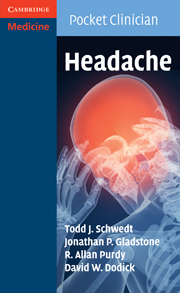53 results
10 - Medication Overuse Headache in the Emergency Department
-
-
- Book:
- Emergency Headache
- Published online:
- 09 October 2017
- Print publication:
- 26 October 2017, pp 99-109
-
- Chapter
- Export citation
Intractable SUNCT Cured After Resection of a Pituitary Microadenoma
-
- Journal:
- Canadian Journal of Neurological Sciences / Volume 33 / Issue 4 / November 2006
- Published online by Cambridge University Press:
- 02 December 2014, pp. 411-413
-
- Article
-
- You have access
- Export citation
26 - Chronic tension-type headache
- from Section 3 - Chronic daily headaches
-
- Book:
- Headache
- Published online:
- 06 July 2010
- Print publication:
- 18 March 2010, pp 143-148
-
- Chapter
- Export citation
3 - Cervical artery dissection
- from Section 1 - Acute headaches
-
- Book:
- Headache
- Published online:
- 06 July 2010
- Print publication:
- 18 March 2010, pp 12-19
-
- Chapter
- Export citation
10 - Introduction to the episodic headaches
- from Section 2 - Episodic headaches
-
- Book:
- Headache
- Published online:
- 06 July 2010
- Print publication:
- 18 March 2010, pp 51-53
-
- Chapter
- Export citation
18 - Chiari malformation headache
- from Section 2 - Episodic headaches
-
- Book:
- Headache
- Published online:
- 06 July 2010
- Print publication:
- 18 March 2010, pp 100-104
-
- Chapter
- Export citation
8 - Primary thunderclap headache
- from Section 1 - Acute headaches
-
- Book:
- Headache
- Published online:
- 06 July 2010
- Print publication:
- 18 March 2010, pp 39-44
-
- Chapter
- Export citation
28 - New daily persistent headache
- from Section 3 - Chronic daily headaches
-
- Book:
- Headache
- Published online:
- 06 July 2010
- Print publication:
- 18 March 2010, pp 155-159
-
- Chapter
- Export citation
2 - Subarachnoid hemorrhage
- from Section 1 - Acute headaches
-
- Book:
- Headache
- Published online:
- 06 July 2010
- Print publication:
- 18 March 2010, pp 6-11
-
- Chapter
- Export citation
7 - Colloid cyst of the third ventricle
- from Section 1 - Acute headaches
-
- Book:
- Headache
- Published online:
- 06 July 2010
- Print publication:
- 18 March 2010, pp 34-38
-
- Chapter
- Export citation
11 - Episodic migraine headache
- from Section 2 - Episodic headaches
-
- Book:
- Headache
- Published online:
- 06 July 2010
- Print publication:
- 18 March 2010, pp 54-63
-
- Chapter
- Export citation
Section 3 - Chronic daily headaches
-
- Book:
- Headache
- Published online:
- 06 July 2010
- Print publication:
- 18 March 2010, pp 127-231
-
- Chapter
- Export citation
Section 1 - Acute headaches
-
- Book:
- Headache
- Published online:
- 06 July 2010
- Print publication:
- 18 March 2010, pp 1-48
-
- Chapter
- Export citation
5 - Ischemic stroke
- from Section 1 - Acute headaches
-
- Book:
- Headache
- Published online:
- 06 July 2010
- Print publication:
- 18 March 2010, pp 26-29
-
- Chapter
- Export citation
Headache - Title page
-
-
- Book:
- Headache
- Published online:
- 06 July 2010
- Print publication:
- 18 March 2010, pp iii-iii
-
- Chapter
- Export citation

Headache
-
- Published online:
- 06 July 2010
- Print publication:
- 18 March 2010
Preface
-
- Book:
- Headache
- Published online:
- 06 July 2010
- Print publication:
- 18 March 2010, pp ix-xii
-
- Chapter
- Export citation
38 - Occipital neuralgia
- from Section 3 - Chronic daily headaches
-
- Book:
- Headache
- Published online:
- 06 July 2010
- Print publication:
- 18 March 2010, pp 224-228
-
- Chapter
- Export citation
27 - Hemicrania continua
- from Section 3 - Chronic daily headaches
-
- Book:
- Headache
- Published online:
- 06 July 2010
- Print publication:
- 18 March 2010, pp 149-154
-
- Chapter
- Export citation
39 - Hypnic headache
- from Section 3 - Chronic daily headaches
-
- Book:
- Headache
- Published online:
- 06 July 2010
- Print publication:
- 18 March 2010, pp 229-231
-
- Chapter
- Export citation



